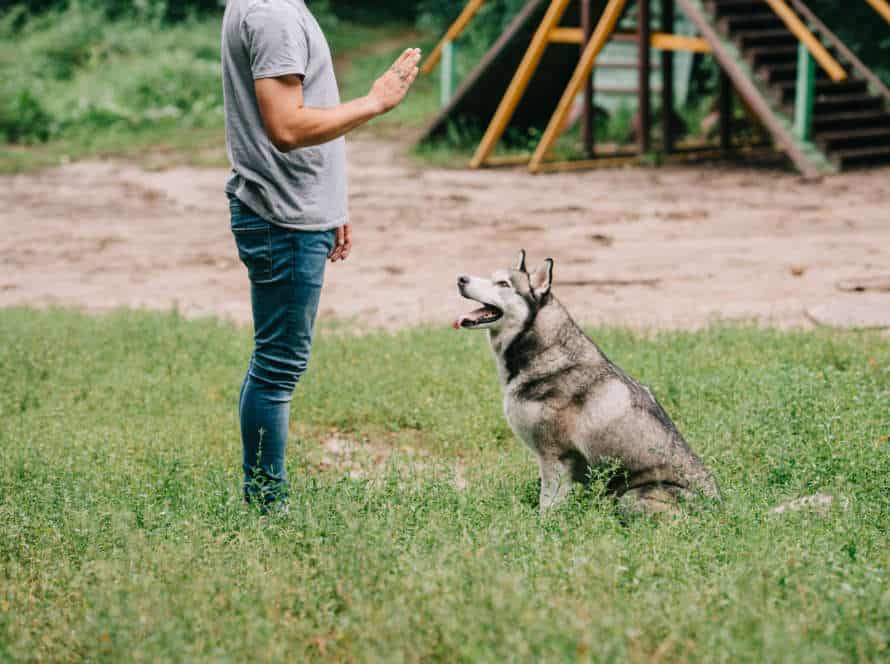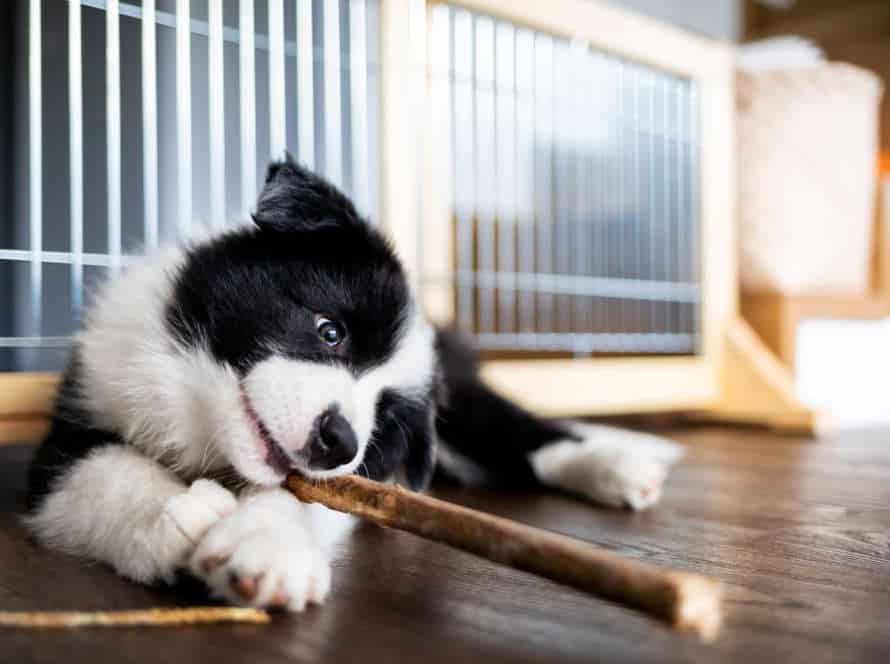The Heel Command for Dogs in Competitive Obedience
The heel command is super important for dogs in competitive obedience. It’s about walking nicely beside the handler, no leash pulling.
Here’s how to teach it:
- Start by attaching the leash and holding it with both hands.
- Stand with your dog on the left side, looking forward.
- Hold a treat in the left hand and offer it close to the body.
- Start walking and encourage your dog to follow the treat and stay on the left.
- Say “heel” as you walk.
- Gradually increase the length and distance.
- Reward good behavior with praise or treats.
- Practice and your pup will soon be walking at your side, no pulling or straying.
Importance of the Heel Command in Competitive Obedience
The heel command is a must for success in competitive obedience. It helps the dog know its spot in relation to its handler. Also, it’s key for going through the show ring and doing a great obedience routine. Let’s focus on the importance of the heel command in competitive obedience.
Understanding the Heel Command
The Heel command is an essential one for dogs in competitive obedience training. Teaching your dog to walk by your side, matching your pace and direction, is crucial! To train your pup on the Heel command, do this:
- Have your dog stand next to you on a leash.
- Hold a treat by your side and start walking. Use a firm voice and say “heel“.
- Keep the treat near you and the leash tight, so the dog stays close.
- Reward them with the treat if they stay in the correct position.
- Repeat the exercise, gradually increasing distance and time.
Pro Tip: Use positive reinforcement! Give treats, praise, and playtime to encourage good behavior. Consistency is the key. It helps build a strong bond between dog and handler.
Benefits of a well-executed Heel Command
The Heel Command is a must-know for all dog owners, especially those into competitive obedience. It offers lots of great benefits. For example:
- More control over your pet’s movements. Teach your pup the Heel Command and you’ll have them at your command!
- Strengthens your bond and communication. Working on the Heel Command helps your relationship with your pup flourish.
- Enhances focus and engagement. Training your pup to heel improves concentration and reduces distraction.
- Increased safety. Heeling helps in public spaces – so you can avoid accidents.
So, it’s clear that Heel Command is an important part of your pup’s training. Not only for competitions, but also to improve control, focus, communication, and safety.
Common mistakes made while teaching Heel Command
When it comes to heel training dogs for competitive obedience, there’re common mistakes to avoid.
Moving quickly is one. Teach basic obedience first!
Correcting too much or too little is another. Consistent, timely corrections help.
Leash management must be correct. Not too tight, not too loose.
And lastly, continuity is key. Be consistent with training for your pup to understand.
Heel training needs patience, consistency, and positive reinforcement for success!
Teaching the Heel Command to Your Dog
Teaching the heel command is vital for competitive obedience for dogs and their handlers. Heel command means the pup stays in a fixed spot and speed beside the handler’s left leg. It takes practice and patience to teach your dog the heel command correctly. This is a must for forming an excellent connection between dog and handler. This article will explain the best ways to teach the heel command to your pup.
Equipment Required for Heel Command Training
Training your pup to obey the “Heel” command is key. To do it right, you need the right gear. Get a good collar and leash for your dog. A flat or martingale collar is best for heel training. Use a standard leash, not too long or short.
You’ll also need a belt pouch or treat bag for positive reinforcement. Wear comfortable shoes for yourself too. These items will make training enjoyable and rewarding for both of you.
Establishing Focus and Engagement with Your Dog
Focus & engagement are vital when training your pup. Teaching the heel command is key for obedience trials. Here’s how:
- Start in a calm, low-distraction environment.
- Put your dog on a leash, standing to their left.
- Hold a treat near their nose with your left hand. Use your right hand to guide them into the heel position (left shoulder alongside your left hip).
- Step forward slowly with your left foot, while saying the heel command.
- If they start pulling or lose focus, instantly give the Sit or Stay command.
- Repeat until your dog walks comfortably in the heel position. With consistent practice, your pup will master the heel command & become a better-behaved & focused companion.
Basic Heel Position and Body Language
Heel command is a must-know in dog obedience training. It’s important to learn the basic heel position and body language. Here’s how:
- Stand next to your pup, with a treat in one hand. Say “heel” in a commanding voice.
- Bring your dog to the left side of your body, with their head in line with your leg.
- Hold the treat close to your body with your left hand. This will keep their attention on you.
- Step forward with your left foot, so your dog follows you.
- Use body language and voice to communicate and reinforce the heel position.
With enough practice, your pup will learn to walk calmly and confidently next to you on a leash. You’ll be able to navigate crowded areas or compete in obedience training with ease.
Techniques for Correcting and Reinforcing Heel Position
To train your pup the heel command, correct heel position is key. Here are 3 techniques that can help.
- The circle method: Begin in a wide circle with your pup beside you. Walk in a smaller circle and stop when your pup moves into the desired heel position. Give praise and reward them. Do this in the other direction too.
- The about-turn method: Start with your pup in the correct heel position. Turn 180 degrees in one go. Your pup should follow you and end up on the opposite side of you in the correct heel position. Repeat until they respond well.
- The halt-sit method: Walk with your pup in the right heel position. Stop and give the sit command. Your pup should sit in the right heel position. Repeat until they respond consistently. Praise and reward them for good behaviour.
Refining the Heel Command
Teaching a dog the heel command? It’s essential for handlers in obedience competitions. Patience, consistency and repetition are key. Break it down into small steps. Include the environment in training. Use corrective feedback. Let’s refine the heel command for top performance.
Incorporating Distractions and Challenges
To perfect the heel command for dogs in competitive obedience, distractions and challenges must be incorporated. These could include strange noises, smells, and moving objects. Here are some tips to do that:
- Start with simple ones at home – like toys or food.
- Move on to those outdoors – like squirrels or other dogs.
- Reward with treats, toys, or praise.
- Change the speed and direction of your movements to keep your pup focused.
- Train in new, unfamiliar places to expose your dog to different settings.
- Keep sessions short and fun – no overwhelming!
With dedication and patience, your pup will be a pro at the heel command in any situation.
Developing Smooth Transitions in Heel Position
To perfect the heel command for competitive dog obedience, smooth transitions are key. For this, dogs must move from one position to another without pause. Here are some tips to refine the heel command:
- Start small – practice in low distraction environments.
- Use treats and praises as rewards.
- Train your dog to maintain heel command while changing direction and speed.
- Introduce new skills like front and finish.
With patience and consistency, your pup can master the heel command. It may take time, but the results will show!
Advanced Techniques for Competition-Level Heel Command
The heel command is an important skill for dogs in obedience trials. To make your pup more competitive, you can refine their heel command with advanced techniques. Here are some tips:
- Use verbal cues and hand signals together to be more precise.
- Vary rewards and heeling times for greater reinforcement.
- Train your pup to heel at different speeds.
- Practice in different environments to get them used to distractions.
By using these techniques, your pup will be well-prepared for high-level obedience competitions.
Common Issues and Problem Solving
The heel command is vital for any pup competing in obedience events. It teaches them to stay close to their handler’s side when strolling. But it can be tricky to teach. Let us explore some common problems and practical solutions for teaching the heel command!
Reluctance to maintain Heel Position
Many pet owners struggle to get their pooch to stay in heel position when teaching it the “heel” command for obedience competitions. Here are some tips to help you out:
- Give treats and compliments when pup is in heel position as a reward.
- Try practicing in different places and with distractions.
- Make sure to hold the leash correctly, firmly but not too tight.
- Clicker training can be useful to encourage good behavior.
- Divide training into smaller parts, and take breaks to prevent pup from getting frustrated.
If you follow these tips, your dog will no longer be reluctant and become an excellent competitor in obedience events!
Lack of Engagement or Interest in Heel Command
The heel command is an important part of competitive obedience training. But, some dogs don’t show much interest in it. This makes it hard to master. Here are some issues you may face and ways to fix them:
Your dog lags behind or pulls ahead? Use a shorter leash and give treats when they stay in the right spot.
Distracted? Find a quiet place and use better treats, like cooked chicken or cheese.
Resists being on the left side? Give rewards and praise when they stay in the right position. Also, try luring with treats.
Struggles with keeping heel position for long periods? Start with short times, like 10 seconds. Gradually increase time as they get more comfortable. Give rewards for longer periods.
Overcorrection or Harsh Treatment during Heel Training
Overcorrection or harsh treatment during heel training is a problem. It can lead to negative consequences like fear, anxiety, and disobedience.
Positive reinforcement is key! Use treats, praises, and other rewards to motivate the dog.
Also, watch their body language. Take breaks if they look overwhelmed.
Positive and patient approaches plus regular training sessions will help your dog master heel command and excel in obedience!
Practicing and Reinforcing Heel Command
The Heel command is a must for dog obedience competition. It’s key in the ring. Practicing and reinforcing it can be tough for the handler and dog. But, with the right techs and patience, you can master it! Benefits abound.
Let’s check out the technique of teaching and reinforcing the Heel command.
Establishing a Regular Training Routine
Creating a solid training routine is key for teaching dogs the ‘heel’ command in competitive obedience. Here are some tricks to help you:
- Set a specific time for training and stay consistent.
- Start with short sessions, and when your pup responds well, increase their length.
- Practice ‘heel’ during each session, rewarding your pup’s good behavior with treats or positive reinforcement.
- Make sessions enjoyable for your pup, adding games and tricks.
- Reinforce the training when out for walks with your pup.
By following these tips, you can have a great training routine that both you and your pup will enjoy!
Rewards and Reinforcement for Consistent Heel Behavior
Heel command practice is essential for dogs in competitive obedience. To incentivise proper behavior and keep heel consistent, rewards and reinforcement come into play. Here are five tips on how to use them:
- Give praise, playtime or treats when the dog performs the heel command correctly.
- Exercise and rest for the dog.
- Utilise verbal cues during practice for the dog to understand the command.
- Reward the dog with a special toy, treat or play session for successful heeling.
- Redirect the dog instead of punishing or scolding.
Through rewards and reinforcement, your dog can master the heel command and keep good habits!
Pitfalls to Avoid During Heel Command Training.
When you’re training your dog to heel, there are a few pitfalls to avoid for success. Here are some common mistakes:
- Inconsistency – Have a consistent routine and use the same commands and techniques.
- Over-correction – Too much force can cause fear. Use positive reinforcement like treats and praise instead.
- Socialization – Dogs need to meet other dogs and humans. Make sure your pooch is comfortable around different people and animals.
- Rushing – Training takes time. Rushing leads to frustration. Go slow and be patient!
Pro tip: Build a strong bond with your pup. Positive reinforcement, consistency, and patience are essential for successful heel command training.
Frequently Asked Questions
Q: What is the Heel Command for Dogs in Competitive Obedience?
A: The heel command is a critical part of competitive obedience training for dogs. It refers to the dog walking on the handler’s left side, with its head and shoulders in line with the handler’s left leg.
Q: Why is the Heel Command important?
A: The heel command showcases the level of control the handler has over the dog, and also proves that the dog can follow instructions and is well-trained. It is a crucial element in competitive obedience as it demonstrates obedience and ability to follow instructions.
Q: When should the Heel Command be taught?
A: The heel command is recommended to be taught early in the dog’s training, after basic commands like sit, stay, come and lie down have been mastered. It is important to introduce the heel command in a positive and encouraging manner, starting in a quiet location free of distractions, gradually increasing the level of complexity and distractions over time.
Q: What are some tips for teaching the Heel Command?
A: It is essential that the handler establishes themselves as the leader and trainer of the dog to successfully teach the heel command. Patience and consistency are key, as well as using the right techniques, like holding the leash and using effective body language, positive reinforcement, and knowing when to give treats.
Q: What are some common mistakes handlers make when teaching the Heel Command?
A: Common mistakes include not holding the leash properly, giving mixed or unclear signals to the dog, and using punishment or negative reinforcement. It is also important to not rush the training process, as the dog must be given adequate time to understand and learn the command.
Q: Is the Heel Command necessary for all dogs?
A: While competitive obedience dogs are required to master the heel command, it can be beneficial for all dogs, especially for those that pull on the leash or become easily distracted while walking. It can improve the relationship between the dog and handler and enhance the dog’s overall obedience and control.







